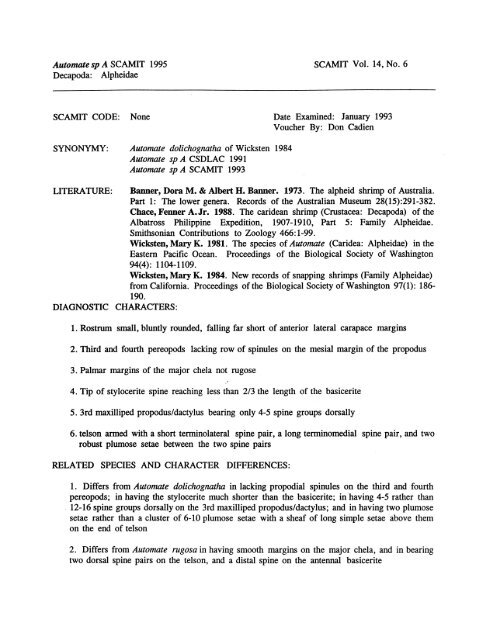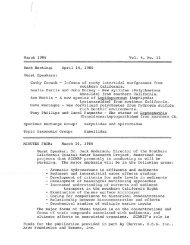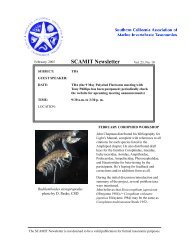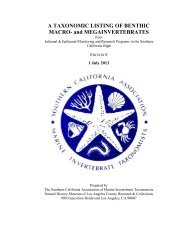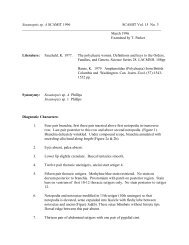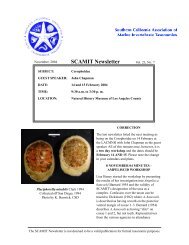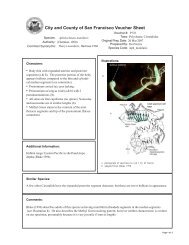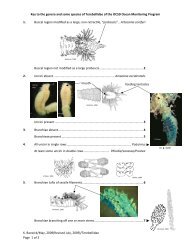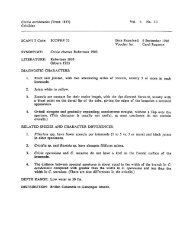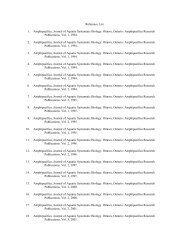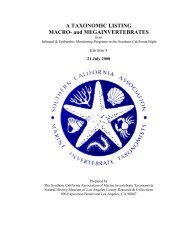Drilonereis pictorial key - scamit
Drilonereis pictorial key - scamit
Drilonereis pictorial key - scamit
You also want an ePaper? Increase the reach of your titles
YUMPU automatically turns print PDFs into web optimized ePapers that Google loves.
Automate sp A SCAMIT 1995<br />
Decapoda: Alpheidae<br />
SCAMIT Vol. 14, No. 6<br />
SCAMIT CODE: None Date Examined: January 1993<br />
Voucher By: Don Cadien<br />
SYNONYMY: Automate dolichognatha of Wicksten 1984<br />
Automate sp A CSDLAC 1991<br />
Automate sp A SCAMIT 1993<br />
LITERATURE: Banner, Dora M. & Albert H. Banner. 1973. The alpheid shrimp of Australia.<br />
Part 1: The lower genera. Records of the Australian Museum 28(15):291-382.<br />
Chace, Fenner A. Jr. 1988. The caridean shrimp (Crustacea: Decapoda) of the<br />
Albatross Philippine Expedition, 1907-1910, Part 5: Family Alpheidae.<br />
Smithsonian Contributions to Zoology 466:1-99.<br />
Wicksten, Mary K. 1981. The species of Automate (Caridea: Alpheidae) in the<br />
Eastern Pacific Ocean. Proceedings of the Biological Society of Washington<br />
94(4): 1104-1109.<br />
Wicksten, Mary K. 1984. New records of snapping shrimps (Family Alpheidae)<br />
from California. Proceedings of the Biological Society of Washington 97(1): 186-<br />
190.<br />
DIAGNOSTIC CHARACTERS:<br />
1. Rostrum small, bluntly rounded, falling far short of anterior lateral carapace margins<br />
2. Third and fourth pereopods lacking row of spinules on the mesial margin of the propodus<br />
3. Palmar margins of the major chela not rugose<br />
4. Tip of stylocerite spine reaching less than 2/3 the length of the basicerite<br />
5. 3rd maxilliped propodus/dactylus bearing only 4-5 spine groups dorsally<br />
6. telson armed with a short terminolateral spine pair, a long terminomedial spine pair, and two<br />
robust plumose setae between the two spine pairs<br />
RELATED SPECIES AND CHARACTER DIFFERENCES:<br />
1. Differs from Automate dolichognatha in lacking propodial spinules on the third and fourth<br />
pereopods; in having the stylocerite much shorter than the basicerite; in having 4-5 rather than<br />
12-16 spine groups dorsally on the 3rd maxilliped propodus/dactylus; and in having two plumose<br />
setae rather than a cluster of 6-10 plumose setae with a sheaf of long simple setae above them<br />
on the end of telson<br />
2. Differs from Automate rugosa in having smooth margins on the major chela, and in bearing<br />
two dorsal spine pairs on the telson, and a distal spine on the antennal basicerite
DEPTH RANGE: 20 - 30m<br />
DISTRIBUTION:<br />
off Church Rock, Catalina Island to Palos Verdes Point, Palos Verdes Peninsula<br />
COMMENTS: This was reported from Catalina Island as A. dolichognatha by Wicksten 1984. Her<br />
specimen lacked legs, and most other characters fell within the bounds of variation of the pantropical<br />
A, dolichognatha (Banner & Banner 1973). The lack of propodial spinules on the third pereopod of<br />
the Palos Verdes specimen separated it immediately from A. dolichognatha (Chace 1988).<br />
Comparison with A. dolichognatha specimens from Mexican waters (Allan Hancock Foundation<br />
Collections, identified by Mary Wicksten) showed both Catalina Channel specimens differed in details<br />
of the stylocerite, 3rd maxilliped, and telsonic armature from southern specimens. The Catalina and<br />
Palos Verdes specimens proved conspecific despite lack of legs on one. The only other species in<br />
the genus reported from waters of Baja California which might range into our area during ENSO<br />
events (A. rugosa) differs considerably in ornamentation of the chelae. The Palos Verdes specimen<br />
was translucent cantalope orange throughout the body when alive. Aside from the scarlet/apricot egg<br />
mass, the only other color was in two bright scarlet eyespots on top of the carapace. These spots<br />
were in roughly the position where eyes would lie in the genus Alpheus.<br />
Figure \)Automate sp A a. 3rd leg, b. 3rd maxilliped, c. telson, d. anterior carapace; Automate<br />
dolichognatha e. 3rd leg, f. 3rd maxilliped, g. telson, h. anterior carapace (a-d 7.3mm CL $$ from<br />
Palos Verdes; e, g-h 7.2mm CL $$ from El Bajo Seamount, Gulf of California, Mexico; f 5.2mm CL<br />
$ ? from Clarion Island, Mexico)


